Acute and chronic kidney disease in elderly patients with hip fracture: prevalence, risk factors and outcome with development and validation of a risk prediction model for acute kidney injury
- PMID: 28088181
- PMCID: PMC5237525
- DOI: 10.1186/s12882-017-0437-5
Acute and chronic kidney disease in elderly patients with hip fracture: prevalence, risk factors and outcome with development and validation of a risk prediction model for acute kidney injury
Abstract
Background: Hip fracture is a common injury in older people with a high rate of postoperative morbidity and mortality. This patient group is also at high risk of acute kidney injury (AKI) and chronic kidney disease (CKD), but little is known of the impact of kidney disease on outcome following hip fracture.
Methods: An observational cohort of consecutive patients with hip fracture in a large UK secondary care hospital. Predictive modelling of outcomes using development and validation datasets. Inclusion: all patients admitted with hip fracture with sufficient serum creatinine measurements to define acute kidney injury. Main outcome measures - development of acute kidney injury during admission; mortality (in hospital, 30-365 day and to follow-up); length of hospital stay.
Results: Data were available for 2848 / 2959 consecutive admissions from 2007-2011; 776 (27.2%) male. Acute kidney injury occurs in 24%; development of acute kidney injury is independently associated with male sex (OR 1.48 (1.21 to 1.80), premorbid chronic kidney disease stage 3B or worse (OR 1.52 (1.19 to 1.93)), age (OR 3.4 (2.29 to 5.2) for >85 years) and greater than one major co-morbidities (OR 1.61 (1.34 to 1.93)). Acute kidney injury of any stage is associated with an increased hazard of death, and increased length of stay (Acute kidney injury: 19.1 (IQR 13 to 31) days; no acute kidney injury 15 (11 to 23) days). A simplified predictive model containing Age, CKD stage (3B-5), two or more comorbidities, and male sex had an area under the ROC curve of 0.63 (0.60 to 0.67).
Conclusions: Acute kidney injury following hip fracture is common and associated with worse outcome and greater hospital length of stay. With the number of people experiencing hip fracture predicted to rise, recognition of risk factors and optimal perioperative management of acute kidney injury will become even more important.
Keywords: Acute kidney injury (AKI); Hip fracture; Hospital length of stay; KDIGO creatinine criteria; Kidney function; Mortality; Postoperative AKI; Surgery; Surgical complication.
Figures
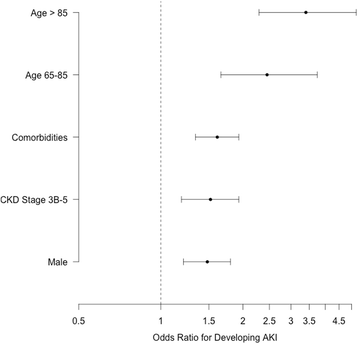
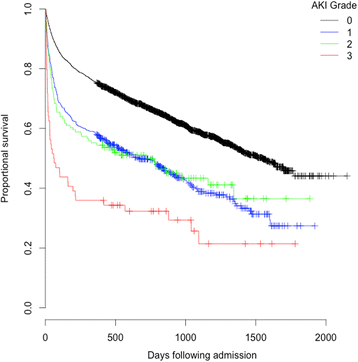
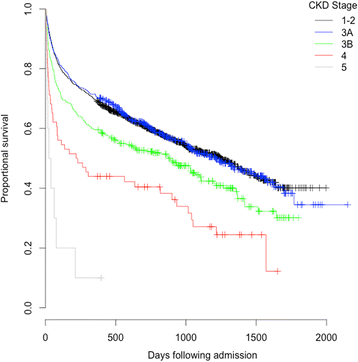
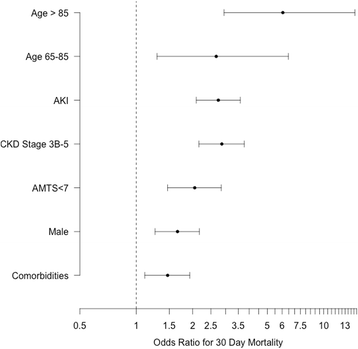
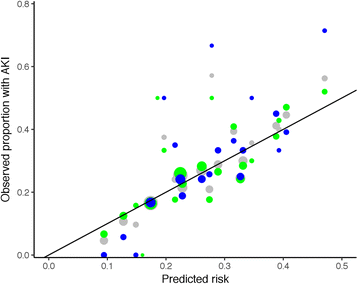
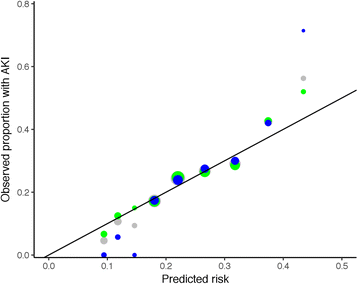
Similar articles
-
Acute Kidney Injury in Patients Undergoing Hip Fracture Surgery.Isr Med Assoc J. 2021 Dec;23(12):815-818. Isr Med Assoc J. 2021. PMID: 34954923
-
Acute Kidney Injury Recovery Pattern and Subsequent Risk of CKD: An Analysis of Veterans Health Administration Data.Am J Kidney Dis. 2016 May;67(5):742-52. doi: 10.1053/j.ajkd.2015.10.019. Epub 2015 Dec 12. Am J Kidney Dis. 2016. PMID: 26690912 Free PMC article.
-
Acute kidney injury following primary hip and knee arthroplasty surgery.Ann R Coll Surg Engl. 2017 Apr;99(4):307-312. doi: 10.1308/rcsann.2016.0324. Epub 2016 Nov 4. Ann R Coll Surg Engl. 2017. PMID: 27809577 Free PMC article.
-
The prevalence and risk factors of acute kidney injury in patients undergoing hip fracture surgery: a meta-analysis.Bioengineered. 2021 Dec;12(1):1976-1985. doi: 10.1080/21655979.2021.1926200. Bioengineered. 2021. PMID: 34034633 Free PMC article.
-
The chronic kidney disease and acute kidney injury involvement in COVID-19 pandemic: A systematic review and meta-analysis.PLoS One. 2021 Jan 5;16(1):e0244779. doi: 10.1371/journal.pone.0244779. eCollection 2021. PLoS One. 2021. PMID: 33400721 Free PMC article.
Cited by
-
ACUTE KIDNEY INJURY FOLLOWING SURGERY FOR HIP FRACTURE.Acta Ortop Bras. 2020 May-Jun;28(3):128-130. doi: 10.1590/1413-785220202803226779. Acta Ortop Bras. 2020. PMID: 32536793 Free PMC article.
-
Risk factors and associated outcomes of acute kidney injury in hip fracture patients.J Orthop. 2021 Jul 26;26:115-118. doi: 10.1016/j.jor.2021.07.019. eCollection 2021 Jul-Aug. J Orthop. 2021. PMID: 34385809 Free PMC article.
-
Hip Fracture Intervention Study for Prevention of Hypotension Trial: a Pilot Randomized Controlled Trial.A A Pract. 2025 Jan 6;19(1):e01891. doi: 10.1213/XAA.0000000000001891. eCollection 2025 Jan 1. A A Pract. 2025. PMID: 39760415 Free PMC article. Clinical Trial.
-
Key Considerations for Frail Patients Undergoing Hip Fracture Surgery.Clin Pract. 2024 Oct 23;14(6):2256-2266. doi: 10.3390/clinpract14060177. Clin Pract. 2024. PMID: 39449385 Free PMC article. Review.
-
Prediction models for acute kidney injury in critically ill patients: a protocol for systematic review and critical appraisal.BMJ Open. 2021 May 19;11(5):e046274. doi: 10.1136/bmjopen-2020-046274. BMJ Open. 2021. PMID: 34011595 Free PMC article.
References
-
- Scottish Intercollegiate Guidelines Group. Prevention and Management of hip fracture in older people. 2009. http://www.sign.ac.uk/pdf/sign111.pdf Accessed 9 Sep 2015.
-
- Borgstrom F, Lekander I, Ivergard M, Strom O, Svedbom A, Alekna V, et al. The International Costs and Utilities Related to Osteoporotic Fractures Study (ICUROS)--quality of life during the first 4 months after fracture. Osteoporosis Int. 2013;24:811–23. doi: 10.1007/s00198-012-2240-2. - DOI - PubMed
Publication types
MeSH terms
Substances
LinkOut - more resources
Full Text Sources
Other Literature Sources
Medical

